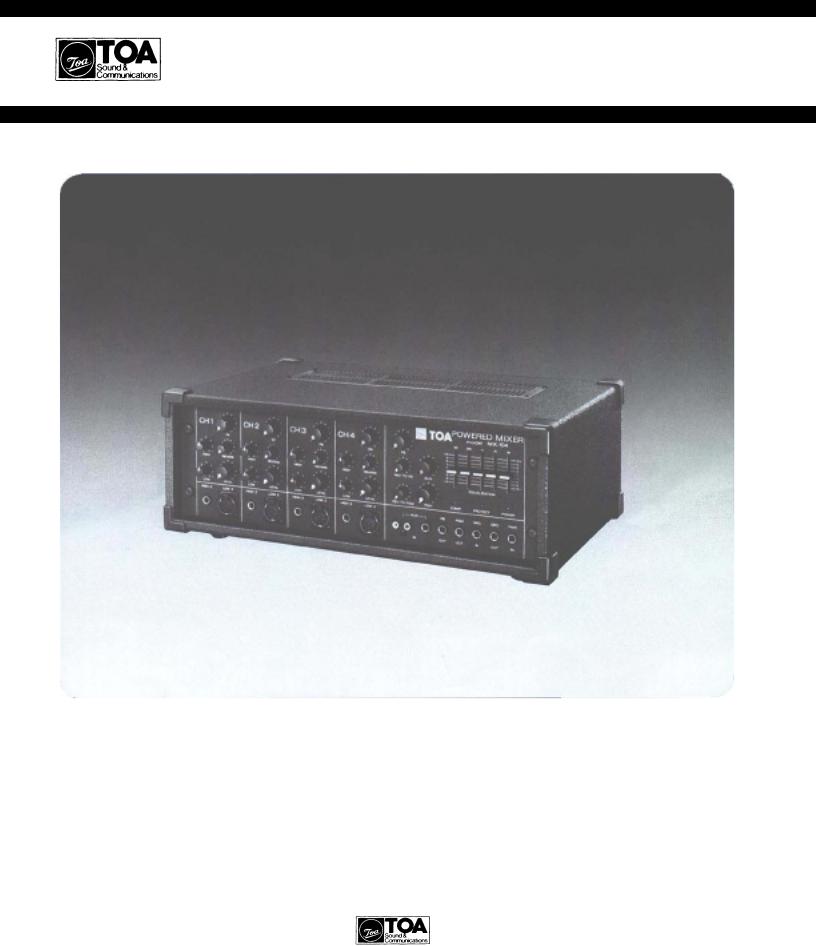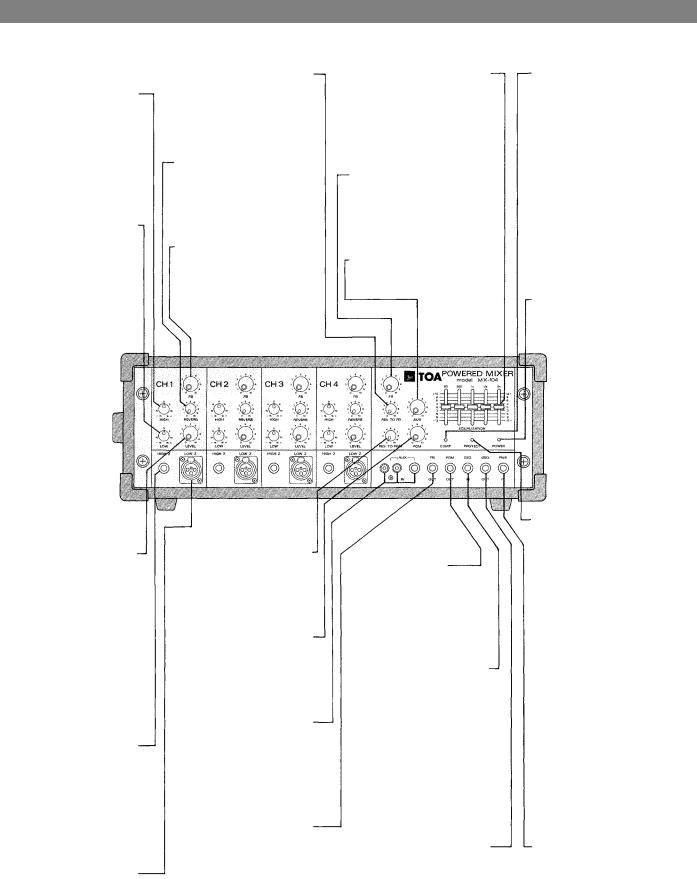Toshiba MX-104 User Manual

Operating Instruction Manual
TOA POWERED MIXER
Model MX-104
TOA ELECTRIC CO., LTD.
KOBE, JAPAN

 Contents
Contents
General Description |
2 |
Features |
2 |
Front Panel [Names of components & their usage] |
3 |
Rear Panel [Names of components & their usage] |
4 |
Connection Examples |
5 |
Input Connections |
6 |
Block and Level Diagrams |
7 |
Specifications |
8 |
Characteristics Diagrams |
9 |
Appearance |
9 |
 Precautions
Precautions
1.XLR Type Audio Connector
The connectors are wired as follows.
The pin 1 is ground [shield), the pin 2 cold (low, minus), the pin 3 hot (high, plus).
2.Description of components and functions on the MX-104.
Various descriptions are applied, depending on each manufacturer. In our Operating and Instruction Manual explanation of components and functions is made according to our usage for them.
— 1 —

 General Description
General Description
The TOA MX-104 is a very compact, four channel self-powered mixer. It was designed to deliver maximum features and performance in a cost-effective portable PA package.
The MX-104 features four input channels, one program output, and one Foldback output. The internal amplifier is rated at 100 watts into an 8 ohm load, and 150 watts into 4 ohms.
Each input channel has an electronically balanced XLR connector, and a high- impedance unbalanced 1/4" phone jack. In addition, each channel features two-band
EQ, a pre-EQ Foldback send, and post-EQ reverb send.
The master control section features a patchable 5-band graphic equalizer, a quality 3- spring reverb, a full patch bay with 1/4" phone auxiliary and RCA tape inputs, and master volume controls for Program, Foldback, and Reverb return to both. The power amp protection circuitry and autocomp compressor, both with LED's, are also located in this section.
 Features
Features
1.Four input channels
2.100 watts into 8 ohms, 150 watts into 4 ohms
3.Patchable 5-band graphic EQ
4.Auto Comp compression unit w/LED
5.Built-in spring reverb
6.Power amp protection circuitry w/LED
7.Full patch bay
8.Aux input w/level control, RCA jacks and parallel phone 1/4" jacks.
9.Reverb level to PGM and FB
10.Independent Foldback mix.
Each Channel
1.Input level control
2.Two band EQ
3.Pre-EQ Foldback send
4.Post-EQ Reverb send
5.Low-Z electronically balanced XLR input
6.Hi-Z unbalanced 1/4" input
— 2 —

 Front Panel
Front Panel
High Equalizer Control (HIGH)
The high EQ control alters the high frequency response of the input channel, providing ±13dB at 10kHz, and ±15dB at 20kHz of continuously variable active shelving equalization. The "0" detented position provides flat audio response.
Low Equalizer Control
(LOW)
The low EQ control provides ±13dB at 100Hz and ±15dB at 50Hz of continuously variable active shelving equalization. The "0" detented position provides flat audio response.
Input Level Control (LEVEL)
The level control provides continuously variable adjustment of the channel output to the program mixing buss, thus determining the level of that channel in the main sound system mix. Since the reverb signal is "post" this control, an increase in the level of the channel's output will also result in a corresponding increase in the reverb effect of that channel. The nominal level of the input level control is at the "10" position.
High Impedance Connectors (HIGH Z)
These connectors are unbalanced, standard 1/4" phone jacks with an input impedance of 27k ohms, and an input level of -35dB. When a plug is inserted into the high - Z input, the corresponding XLR connector is automatically switched out of the input circuitry.
Low Impedance Connectors
(LOW Z)
The XLR connectors are low impedance, electronically balanced inputs with an input impedance of 1k ohms.
Reverb to Foldback Control (REV TO FB)
This control adjusts the amount of reverb signal that is returned to the foldback buss and thus the level of reverb contained in the on-stage monitor mix.
Reverb/Control
(REV)
This control determines the level of signal assigned to the reverb mixing buss. Rotating the control clockwise increases the amount of reverb in that channel.
Foldback Control (FB)
The Foldback control determines the level of signal assigned to the foldback mixing buss, thus setting the level of that channel in the on-stage monitor mix.
Reverb to Program Contro1
(REV TO PGM)
This control adjusts the amount of reverb signal that is returned to the program buss and thus the level of reverb contained in the main sound system.
Program Master Control
(PGM)
The PGM control adjusts the overall combined signal level of the four independent channel level controls, and thus the level of the main sound system.
Aux Input Jacks
(AUX IN)
The phone jack and RCA pin jacks are wired in parallel, with an input level of -20dB. When a plug is inserted into the phone jack, the RCA pin jacks are automatically switched out of the AUX circuitry.
Foldback Output Jack
(FB OUT)
This jack is for connection to external power amplifiers and/ or equalizers for the on-stage monitoring system. Nominal output level is +4dB with an impedance of 600 ohms. If the internal power amp and equalizer are to be used for the onstage monitor system, the FB output should be connected to the GEQ input jack.
Graphic Equalizer (EQUALIZATION)
The graphic equalizer is 5 independent active bands (filters), providing 12dB of boost or cut at each center frequency. The "0" detented position provides flat audio response.
Foldback Master Control (FB)
The FB master control adjusts the overall combined signal level of the four independent channel foldback sends, and thus the level of the entire on-stage monitor mix.
Aux Level Control (AUX)
This control sets the overall level of the Aux input signal.
Program Output Jack
(PGM OUT)
The PGM Out jack is provided for connection to external equalizers and/or power amps, deriving its signal prior to the internal GEQ and power amp. Nominal output level is +4dB with an impedance of 600 ohms.
Graphic Equalizer Input Jack -
(GEQ IN)
The GEQ input jack allows the graphic equalizer to be used independently of the MX-104 with other external equipment, or the internal power amplifier and the graphic equalizer with external equipment. When a plug is inserted, the main mix from the program buss isdisconnected from the graphic equalizer and the power amplifier. The nominal input level is +4dB with an input impedance of 50k ohms.
Graphic Equalizer Output Jack
(GEQ OUT)
This jack allows the MX-104 and the internal graphic equalizer to be used w i t h an external power amplifier, or in conjunc - tion with t h e GEQ in jack, to be used independently of all other MX-104 c i r c u i t r y . Nominal o u t p u t level is +4dB w i t h an impedance of 600 ohms.
Power Amp Compression Indicator
(COMP)
The Comp LED lights when the internal compressor is activated. The compressor is provided to protect speaker systems by compressing the input signal level of the power amplifier when clipping occurs in the output stage. Frequent flashing of the LED is not reason for alarm. However, a constant or steady light indicates that the MX-104 is being overdriven and that the internal power amplifier is possibly "under powered" for that application. The output level of the MX104 should be decreased until the LED only flashes intermittently.
Power Indicator LED (POWER)
The indicator LED lights when the power switch is "on".
Power Amp Protection
Indicator (PROTECT)
The indicator LED lights if the power amplifier output is shorted, if the temperature of the unit rises above acceptable levels, or if DC is drifted to the speaker outputs. If the LED should light, speaker wiring and ambient temperature of the MX-104 should be checked. If the LED remains lighted, the unit should be referred to qualified service personnel for repair.
Note:
The MX-104 protection circuitry will (1) detect 'faulty conditions' within the power amplifier, (2) give a visual indication, and (3) automatically shut down until the fault condition is alleviated. This special circuitry ensures maximum reliability and virtually eliminates equipment damage due to unsafe or fault conditions. Please refer to fault protection table on page 4 for full explanation of this important feature.
Power Amplifier Input Jack (PWR IN)
The PWR Amp input jack allows the internal power amplifier to be used with external equipment. When a plug is inserted, t h e power amp is a u t o m a t i c a l l y disconnected from the MX-104 mixer section. The nominal in- p u t level is +4dB with an input impedance of 10k ohms.
— 3 —
